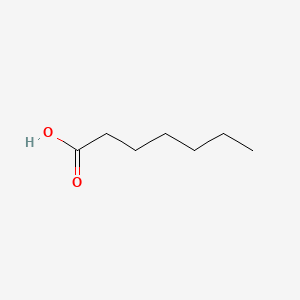| MeSH term | MeSH ID | Detail |
|---|---|---|
| Olfaction Disorders | D000857 | 17 associated lipids |
| Byssinosis | D002095 | 11 associated lipids |
| Mitochondrial Diseases | D028361 | 25 associated lipids |
HEPTANOIC ACID
HEPTANOIC ACID is a lipid of Fatty Acyls (FA) class. Heptanoic acid is associated with abnormalities such as Dehydration. The involved functions are known as Process, Anabolism, inhibitors, Oxidation and fatty acid oxidation. The related lipids are Heptanoates and undecanoic acid.
Cross Reference
Introduction
To understand associated biological information of HEPTANOIC ACID, we collected biological information of abnormalities, associated pathways, cellular/molecular locations, biological functions, related genes/proteins, lipids and common seen animal/experimental models with organized paragraphs from literatures.
What diseases are associated with HEPTANOIC ACID?
HEPTANOIC ACID is suspected in Dehydration and other diseases in descending order of the highest number of associated sentences.
Related references are mostly published in these journals:
| Disease | Cross reference | Weighted score | Related literature |
|---|
Possible diseases from mapped MeSH terms on references
We collected disease MeSH terms mapped to the references associated with HEPTANOIC ACID
PubChem Associated disorders and diseases
What pathways are associated with HEPTANOIC ACID
There are no associated biomedical information in the current reference collection.
PubChem Biomolecular Interactions and Pathways
Link to PubChem Biomolecular Interactions and PathwaysWhat cellular locations are associated with HEPTANOIC ACID?
There are no associated biomedical information in the current reference collection.
What functions are associated with HEPTANOIC ACID?
Related references are published most in these journals:
| Function | Cross reference | Weighted score | Related literatures |
|---|
What lipids are associated with HEPTANOIC ACID?
Related references are published most in these journals:
| Lipid concept | Cross reference | Weighted score | Related literatures |
|---|
What genes are associated with HEPTANOIC ACID?
There are no associated biomedical information in the current reference collection.
What common seen animal models are associated with HEPTANOIC ACID?
There are no associated biomedical information in the current reference collection.
NCBI Entrez Crosslinks
All references with HEPTANOIC ACID
Download all related citations| Authors | Title | Published | Journal | PubMed Link |
|---|---|---|---|---|
| pmid: | ||||
| Fiume MM et al. | Safety assessment of stearyl heptanoate and related stearyl alkanoates as used in cosmetics. | Int. J. Toxicol. | pmid:23064772 | |
| Liao LL and Richardson KE | The inhibition of oxalate biosynthesis in isolated perfused rat liver by DL-phenyllactate and n-heptanoate. | 1973 | Arch. Biochem. Biophys. | pmid:4689788 |
| Salanitro JP and Muirhead PA | Quantitative method for the gas chromatographic analysis of short-chain monocarboxylic and dicarboxylic acids in fermentation media. | 1975 | Appl Microbiol | pmid:1167776 |
| Ueda T et al. | Response of Nitella internodal cell to chemical stimulation. A model for olfactory receptor system. | 1975-1976 | J. Membr. Biol. | pmid:1235804 |
| Becker R | [Fluorometric determination of glibornuride in plasma and serum using 7-chloro-4-nitrobenzo-2-oxa-1,3-diazole]. | 1977 | Arzneimittelforschung | pmid:139896 |
| Marovitz WF and Khan KM | Scanning electron microscopic appearance of rat otocyst of the twelfth postcoital day: elaboration of a method. | 1977 Jan-Feb | Ann Otol Rhinol Laryngol Suppl | pmid:402880 |
| Basit N et al. | Studies on the inhibitory effects of zinc heptanoate on microorganisms. | 1979 Jan-Jun | G Batteriol Virol Immunol | pmid:553835 |
| Grimm LJ et al. | Inhibition of platelet thromboxane synthesis by 7-(1-imidazolyl) heptanoic acid: dissociation from inhibition of aggregation. | 1981 | Thromb. Res. | pmid:6801806 |
| Yasuda Y et al. | Quantitative structure-inhibitory activity relationships of phenols and fatty acids for Bacillus subtilis spore germination. | 1982 | J. Med. Chem. | pmid:6802973 |
| Fujisawa K | Effects of a new alpha-adrenoceptor blocking agent, ethyl-7-[4-(2-methoxyphenyl)-1-piperazinyl] heptanoate dihydrochloride (SGB-483), on smooth muscle and neuromuscular transmission in guinea-pig mesenteric artery. | 1983 | Br. J. Pharmacol. | pmid:6140055 |
| Chong KP et al. | Vasopressin stimulates thromboxane synthesis in isolated hamster hepatocytes: relation to hepatocyte calcium content. | 1983 | Prostaglandins | pmid:6419286 |
| Rybicki JP and Le Breton GC | Prostaglandin H2 directly lowers human platelet cAMP levels. | 1983 | Thromb. Res. | pmid:6310815 |
| Hirsch RF and Rachlin EM | Ion-sensitive electrode potentiometry of organic anions: application to quantitative structure-activity relationships. | 1983 | J. Med. Chem. | pmid:6887198 |
| Dmitriev VV et al. | [Action of hyperoxia on the total electrical activity of the olfactory epithelium of the frog]. | 1984 | Fiziol Zh SSSR Im I M Sechenova | pmid:6724040 |
| Yu MW and Finlayson JS | Quantitative determination of the stabilizers octanoic acid and N-acetyl-DL-tryptophan in human albumin products. | 1984 | J Pharm Sci | pmid:6694090 |
| Tonosaki K and Shibuya T | Olfactory receptor cell responses of pigeon to some odors. | 1985 | Comp Biochem Physiol A Comp Physiol | pmid:2864176 |
| Mundie TG and Ainsworth SK | Byssinosis: thromboxane release from human platelets by cotton dust and bract extracts. | 1985 May-Jun | Arch. Environ. Health | pmid:4026387 |
| Guzmán A et al. | Hypoglycemic activity in male rats of bicyclo (3, 1, 0) hexane-6-carboxylic acid derivatives. | 1985 Oct-Dec | Arch Invest Med (Mex) | pmid:3842921 |
| Inokuchi A et al. | Olfactory evoked potentials in the rat. | 1986 | Laryngoscope | pmid:3762286 |
